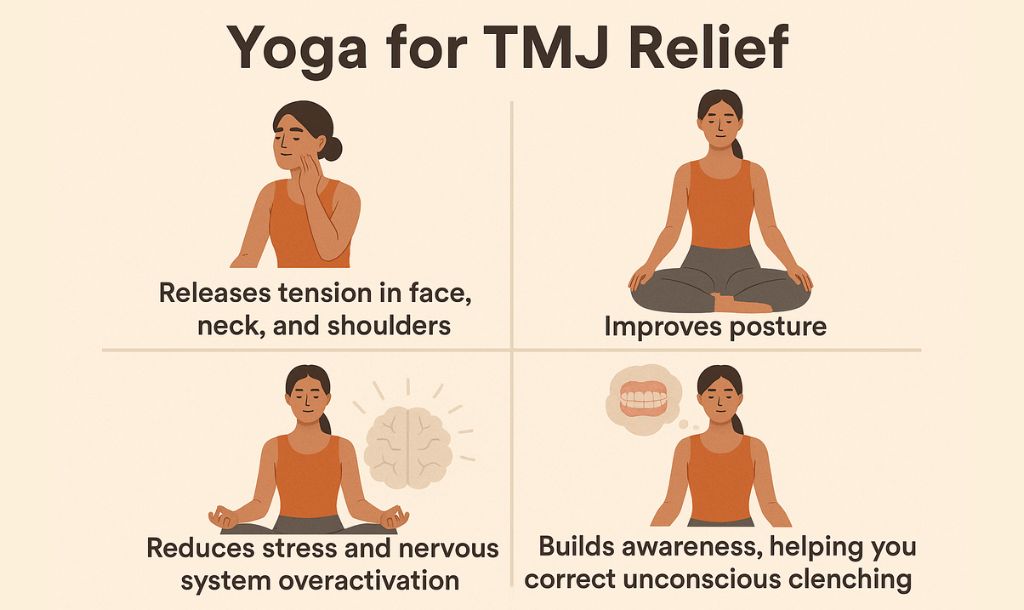What is Bhujangasana (Cobra Pose)?
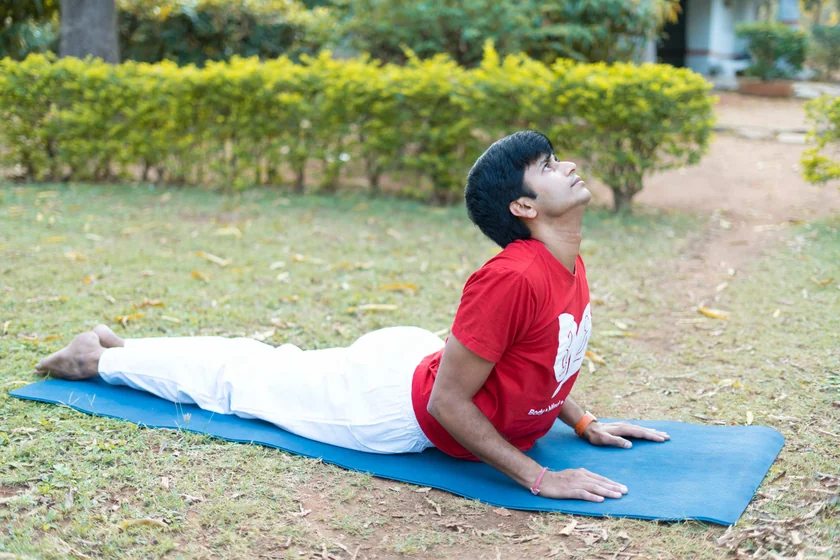
Bhujangasana (Cobra Pose) is a foundational backbending yoga pose performed lying face down. This beginner-friendly pose strengthens spinal muscles, opens the chest and shoulders, and may help reduce back pain. Regular practice improves posture, increases flexibility, and provides stress relief through heart-opening chest expansion.
Bhujangasana: Overview and Meaning of Cobra Pose
Bhujangasana comes from the Sanskrit words Bhujanga (serpent or snake) and Asana (pose). The name reflects the posture’s resemblance to a cobra rising with its hood expanded. While known as Cobra Pose or Serpent Pose in English, some traditional texts also refer to it as Sarpasana.
Symbolically, the cobra represents awakening, transformation, and resilience. Just as a snake sheds its skin to renew itself, Bhujangasana represents growth and rejuvenation—both physical and spiritual. The chest-opening action is associated with courage, confidence, and emotional release.
In classical yoga texts, Bhujangasana is described for its therapeutic and energizing effects. The Gheranda Samhita (17th century) explains the posture as a way to strengthen the spine, invigorate the body, and awaken inner vitality. Over time, it has become an essential part of Surya Namaskar (Sun Salutations) and other flow-based yoga practices, preparing practitioners for deeper backbends and pranayama.
At a Glance
Sanskrit Name: भुजंगासन
Pronunciation: Bhu-jung-AHS-uh-nuh
Pose Type: Backbend, Heart Opener
Also Known As: Cobra Pose, Serpent Pose, Sarpasana
Strengthens: Spine, shoulders, arms
Stretches: Chest, abdomen, hip flexors
Benefits of Bhujangasana
Bhujangasana, or Cobra Pose, offers a blend of physical, mental, and therapeutic benefits.
Physical Benefits
- Strengthens the back and spine: Lifting the chest works the back muscles and glutes, improving posture and making your spine stronger.
- Increases spinal flexibility: This pose gently stretches your upper and lower back, making it easier to bend and move without stiffness.
- Opens the chest and shoulders: It expands the chest and stretches the shoulders, helping counter rounded shoulders from sitting long hours.
- Supports digestion: Gentle pressure on the abdomen stimulates the digestive organs and helps your metabolism work better.
- Eases lower back pain and stiffness: Cobra Pose strengthens the lower back safely, reducing mild discomfort and tension.
Mental & Emotional Benefits
- Reduces stress and anxiety: Opening the chest encourages deep, calming breaths that relax the nervous system.
- Boosts energy and mood: This pose increases blood flow and stimulates the adrenal glands, leaving you feeling more energetic.
- Builds confidence: The upright, expansive posture naturally lifts your mood and makes you feel more self-assured.
- Improves focus and clarity: Coordinating breath and movement helps the mind stay alert and present.
Spiritual Benefits
- Opens the heart chakra: The chest-opening nature of the pose encourages emotional openness and compassion.
- Promotes inner strength and resilience: Lifting the chest like a cobra rising symbolizes courage and awakening energy within.
- Enhances mindfulness and presence: The gentle backbend encourages connection between body and breath, creating a sense of calm awareness.
How to do Bhujangasana (Cobra Pose)?
Part 1: Preparing for Bhujangasana
Before practicing Bhujangasana (Cobra Pose), it’s important to warm up the spine, shoulders, and chest to prevent strain and make the pose more comfortable. Try these gentle preparatory poses:
1. Cat-Cow Stretch (Marjaryasana-Bitilasana)
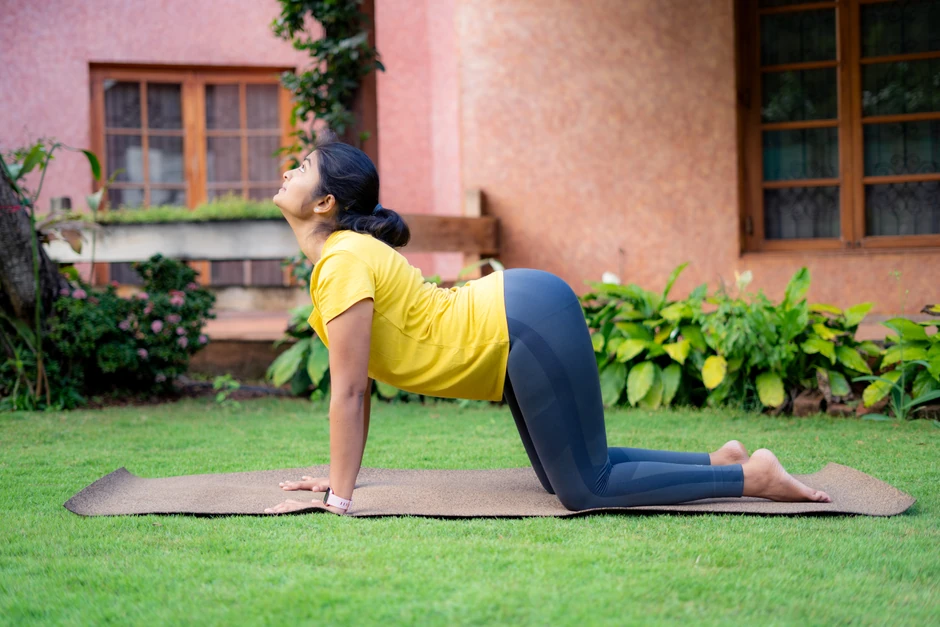
This dynamic movement helps mobilize and warm up the spine.
- Begin on hands and knees, wrists under shoulders, and knees under hips.
- Inhale, drop the belly, and lift the chest and tailbone (Cow).
- Exhale, round the spine, tucking the chin and tailbone (Cat).
- Repeat for 6–8 rounds to mobilize the spine.
2. Child’s Pose (Balasana)
_optimized.webp)
This is a great pose to lengthen the back muscles.
- Kneel on the mat with big toes touching and knees apart.
- Sit back on your heels and stretch your arms forward, resting your forehead on the mat.
- Breathe deeply, feeling your spine lengthen.
- Hold for 30–60 seconds.
3. Sphinx Pose (Salamba Bhujangasana)
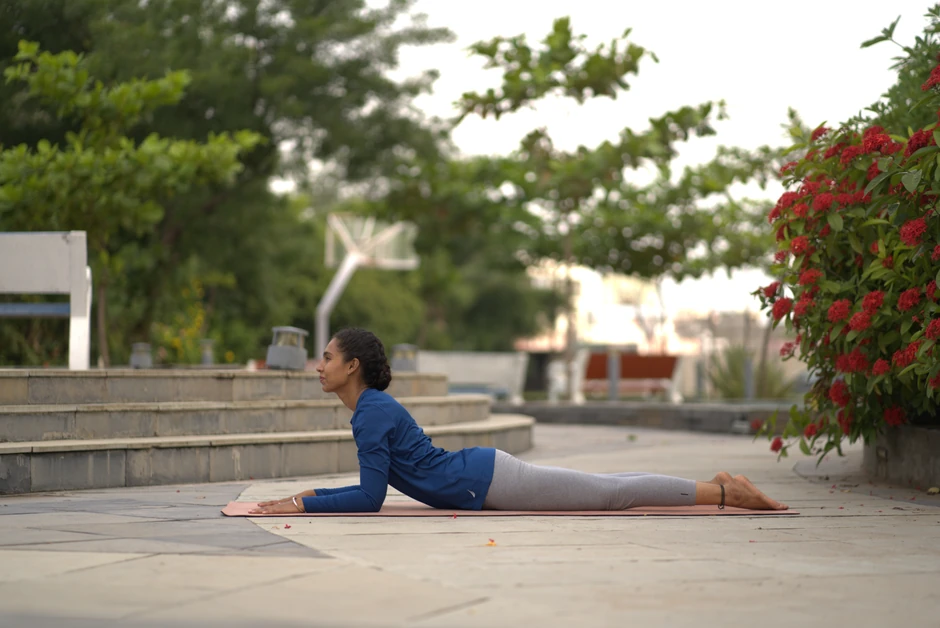
This pose serves as a gentler backbend to prepare for the full pose.
- Lie on your stomach with forearms on the mat, elbows under your shoulders.
- Lift your chest slightly using your back muscles.
- Hold for 20–30 seconds to gently activate the spine and chest.
Part 2: Step-by-Step Instructions for Bhujangasana
- Lie face down on your mat with legs extended and the tops of your feet pressing lightly into the floor. Rest your forehead on the mat.
- Place your palms flat under your shoulders, fingers spread wide, with elbows close to your body.
- Press your legs, thighs, and feet into the mat while activating your glutes lightly.
- Inhale, press the pubic bone down, and lift your chest using your back muscles.
- Roll your shoulders back and down, broadening the collarbones and lifting the sternum forward.
- Straighten your arms as comfortably as possible, keeping elbows soft and maintaining a gentle gaze forward or slightly upward.
- Maintain steady breathing, holding for 15–30 seconds if a beginner, up to 1–3 minutes if advanced.
- Exhale, gently lower your chest, shoulders, and forehead to the mat, and turn your head to one side to relax the neck.
Part 3: Tips for Proper Alignment and Safety
- Engage the core: Protects the lower back and maintains an even lift.
- Don’t overarch: Lengthen through the tailbone to avoid compressing the spine.
- Relax your shoulders: Keep them away from your ears.
- Gaze softly: Avoid straining the neck by looking too far up.
- Use props if needed: A folded blanket under the pelvis can reduce lower back discomfort.
- Cool Down: After Bhujangasana, release tension with these poses:
Learn Bhujangasana step-by-step with a coach. Book a free 1-on-1 session today!
Bhujangasana Variations to Consider
Bhujangasana (Cobra Pose) can be made more accessible for beginners, more dynamic for intermediates, or more challenging for advanced yogis. Here are the most common variations of Bhujangasana and their unique benefits.
Beginner Variations
1. Ardha Bhujangasana (Half Cobra Pose)
This pose provides a gentle backbend that strengthens the upper body and improves posture.
- Lie on your stomach, legs extended, and forehead resting on the mat.
- Place forearms on the ground with elbows directly under shoulders.
- Inhale and lift the chest, keeping forearms firmly grounded.
- Hold for 20–30 seconds, breathing steadily.
2. Sphinx Pose (Salamba Bhujangasana)
This is a great pose to build endurance in a safe backbend while expanding the chest and lungs.
- Begin lying prone with legs extended.
- Bring forearms parallel on the mat, elbows under shoulders.
- Press into forearms and lift the chest, keeping shoulders relaxed.
- Stay for 30–60 seconds.
Intermediate Variations
3. Tiryak Bhujangasana (Twisted Cobra Pose)
This pose improves spinal mobility and digestion through gentle twisting.
- Start in traditional Bhujangasana.
- On an exhale, gently twist your torso to the right, gazing over your shoulder.
- Hold for 15–20 seconds, then return to center.
- Repeat on the left side.
Advanced Variations
4. King Cobra Pose (Bhujangasana II)
This pose deeply opens the chest and spine while building strength in the back and legs.
- From full Cobra, bend the knees and bring the feet toward the head.
- If possible, lift higher and reach the head back toward the toes.
- Hold for 10–15 seconds, breathing steadily.
5. One-Armed Cobra Pose
This pose strengthens the back and core while improving balance and shoulder stability.
- Begin in Cobra Pose.
- Place one palm under the shoulder and extend the opposite arm backward along the side.
- Press with one arm to lift the torso, keeping the chest open.
- Switch sides.
Bhujangasana Precautions & Contraindications
Bhujangasana (Cobra Pose) is a powerful backbend, but like all yoga postures, it should be practiced with awareness. Knowing when to avoid or modify this pose is essential for safety.
Avoid Bhujangasana if you have:
- Recent back surgery or severe back injury - as the backbend may strain healing tissues.
- Herniated discs or chronic spinal conditions - can worsen existing issues.
- Pregnancy (second and third trimester) - deep backbends compress the abdomen.
- Severe arthritis in the spine - the extension may aggravate pain.
- Recent abdominal surgery – increased intra-abdominal pressure may delay recovery.
- Severe migraines or headaches – the back arch may trigger symptoms.
Practice with caution in case of:
- Neck injuries – keep the head neutral, avoid tilting back.
- Wrist problems – try Sphinx Pose (forearms on mat) instead of pressing palms.
- High blood pressure – avoid deep lifts, practice gentler versions.
- Menstruation – it’s generally safe, but listen to your body and choose gentler forward bends if you feel discomfort.
Safety Tips for Bhujangasana
- Always warm up the spine with gentle stretches before practicing.
- Keep the movement gradual — never jerk or force the lift.
- Maintain shoulders away from ears to avoid neck strain.
- Exit the pose slowly if you feel sharp pain, dizziness, or discomfort.
- When in doubt, consult a yoga coach for guidance.
Book a free 1-on-1 session for personalized guidance on Cobra Pose today!
Bhujangasana (Cobra Pose): Related Poses
If you enjoy Cobra Pose, here are a few similar backbends that share its benefits while offering new challenges:
1. Camel Pose (Ustrasana)
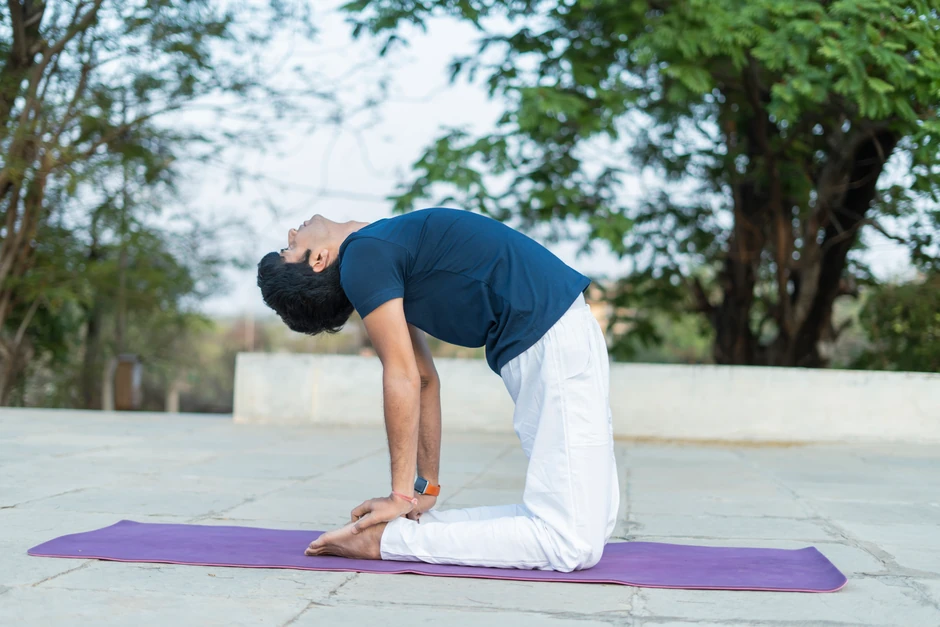
This pose deeply opens the chest and shoulders while strengthening the spine.
- Kneel on the mat with knees hip-width apart.
- Place your hands on your lower back or heels.
- Inhale, lift your chest, and gently press your hips forward.
- Drop your head back only if it feels comfortable.
2. Fish Pose (Matsyasana)
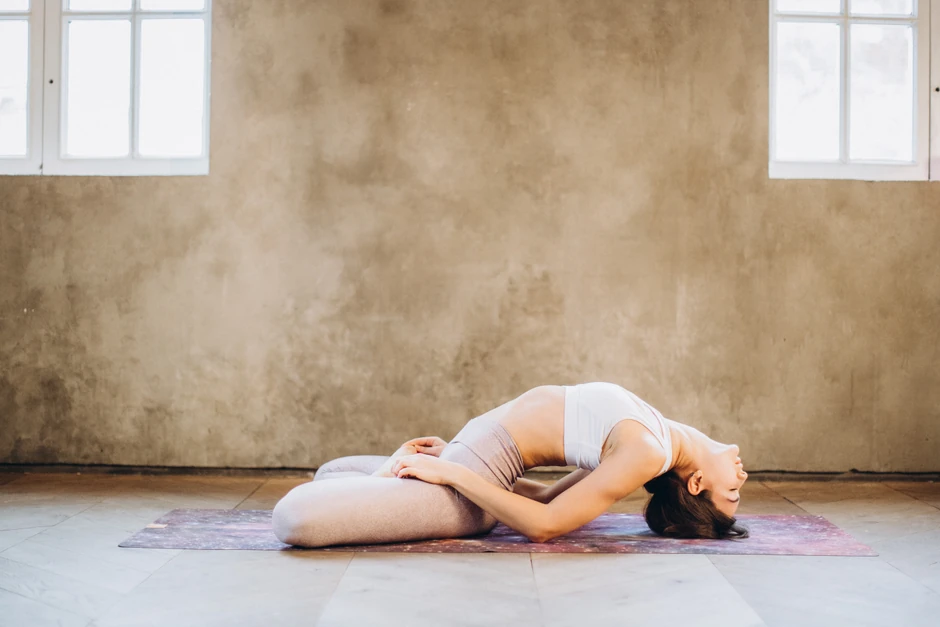
This pose expands the rib cage, improves posture, and relieves neck and upper back tension.
- Lie on your back with legs extended.
- Place your hands under your hips, palms facing down.
- Inhale, press into your elbows, and lift your chest.
- Let the crown of your head rest lightly on the mat.
3. Bow Pose (Dhanurasana)
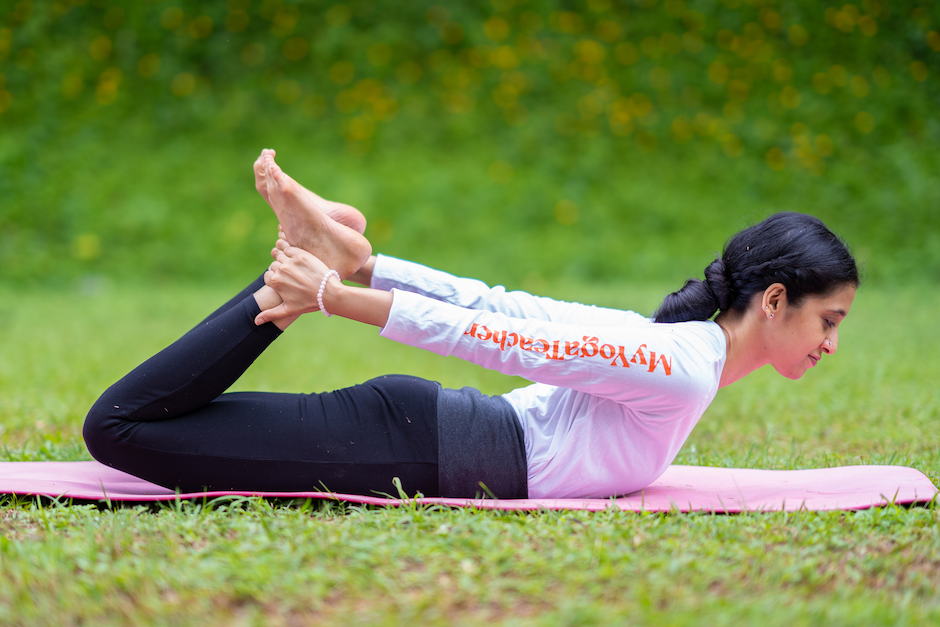
Bow Pose strengthens the entire back and gives a full-body stretch.
- Lie on your stomach with arms by your sides.
- Bend your knees and hold your ankles with your hands.
- Inhale, lift your chest and thighs off the floor.
- Gaze forward and keep breathing steadily.
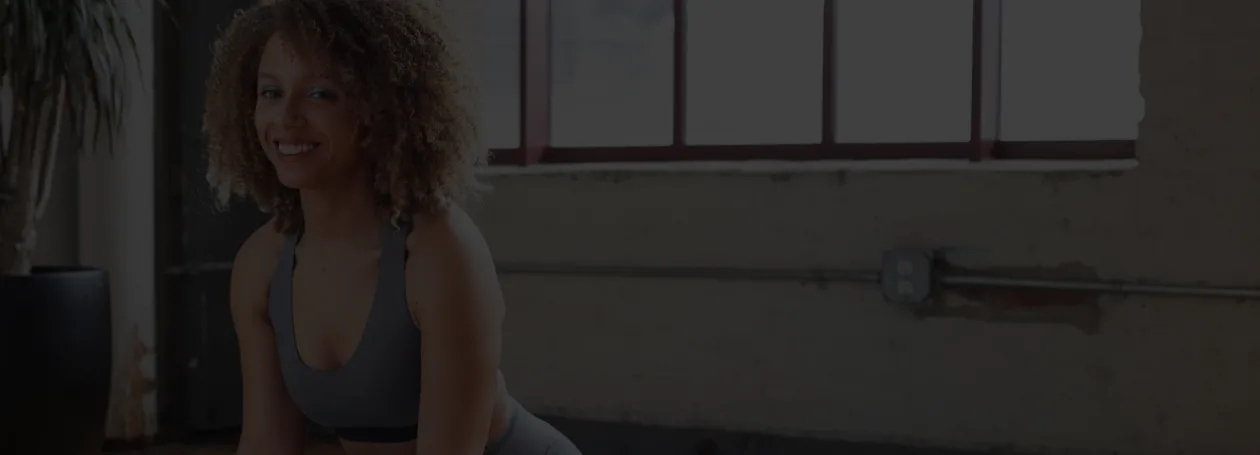
Enjoy a Free 1-on-1 Session with a Coach!
Receive personalized guidance tailored to your unique fitness goals, live with a dedicated coach—no credit card required.
Frequently Asked Questions
Bhujangasana (Cobra Pose) engages the abdominal muscles and stimulates circulation in the core, which, when practiced regularly along with a healthy lifestyle, may help reduce belly fat.
The duration depends on your experience:
- Beginners: 15–30 seconds
- Intermediate practitioners: 30–60 seconds
- Advanced practitioners: 1–3 minutes (with steady breath and no strain)
Always focus on correct form and controlled breathing rather than forcing longer holds.
Yes, Cobra Pose can help reduce mild back pain by strengthening spinal muscles and improving flexibility. However, avoid if you have herniated discs, recent back surgery, or acute injury. Always consult a healthcare provider for chronic back issues.
Both are prone backbends, but with key differences:
- Sphinx Pose (Salamba Bhujangasana): Forearms stay on the mat, creating a milder, beginner-friendly backbend.
- Cobra Pose (Bhujangasana): Hands are under the shoulders, and the arms extend to lift the chest higher, resulting in a deeper stretch and more spinal engagement.
Bhujangasana can support overall metabolism and improve circulation, which may benefit people with mild diabetes as part of a holistic yoga routine, but it should not replace medical treatment. Always consult your doctor before starting yoga for diabetes.
Generally, mild backbends like Bhujangasana are safe during menstruation if you feel comfortable. However, women experiencing cramps or discomfort may prefer gentler poses such as Sphinx Pose or Child’s Pose. Listen to your body and avoid forcing the backbend.


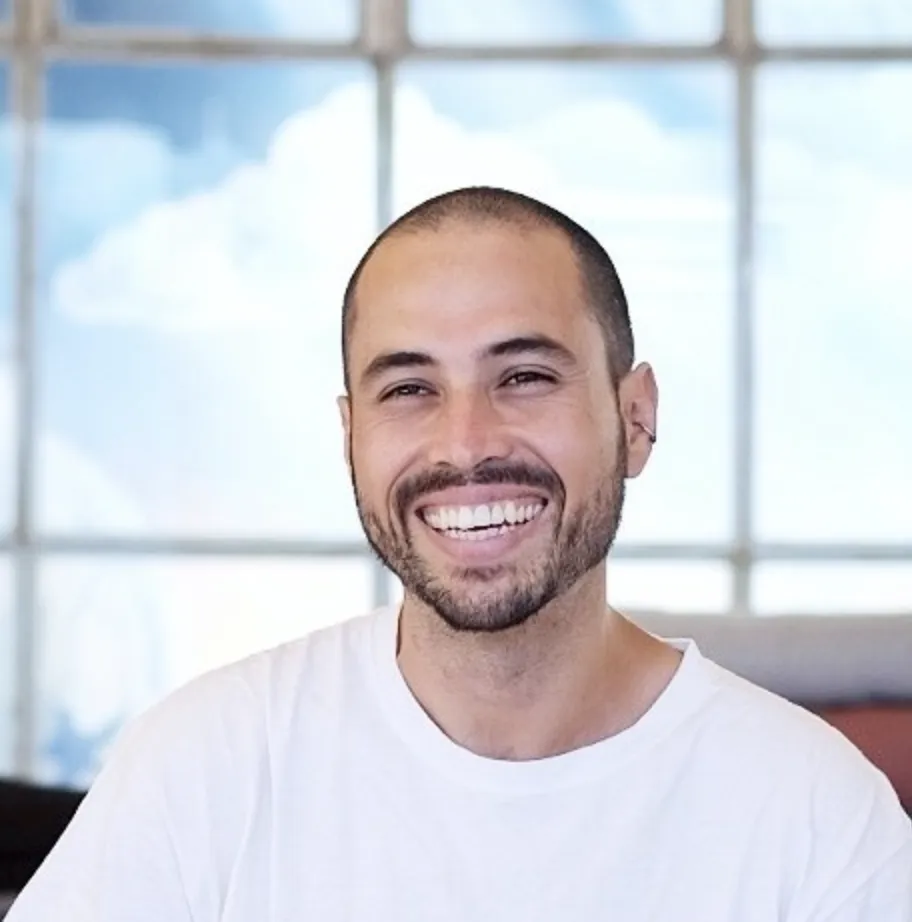
.webp)
%20(7).jpg)
